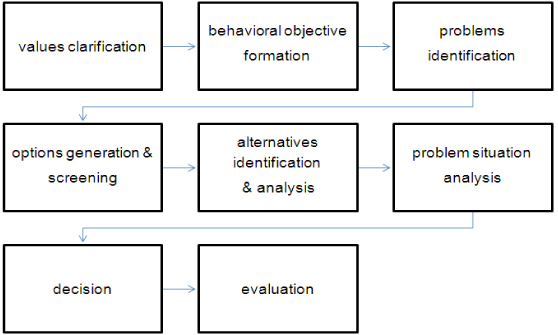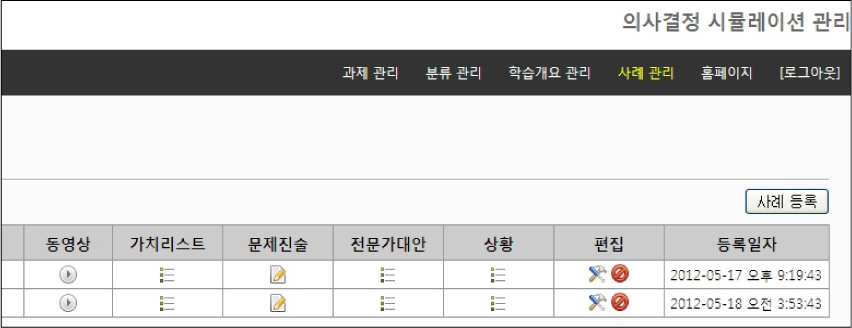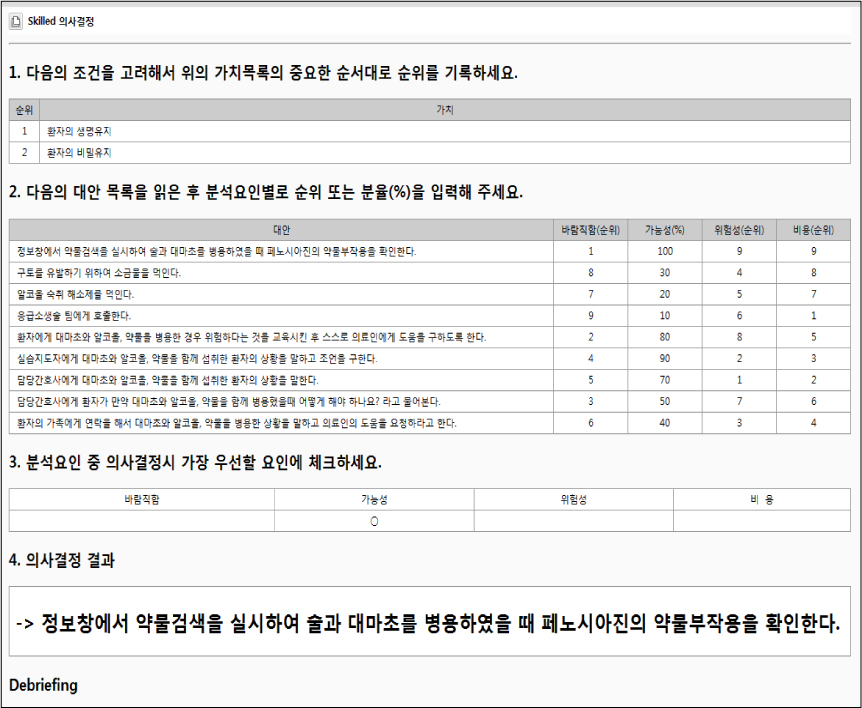J Korean Acad Nurs Adm.
2014 Mar;20(2):227-236.
Development and Evaluation of a Web-based Simulation Program on Patient Rights Education using Integrated Decision Making Model for Nurse Students
- Affiliations
-
- 1Department of Nursing, Wonju College of Medicine, Yonsei University, Korea. kyongkk@yonsei.ac.kr
Abstract
- PURPOSE
This study was designed to develop and evaluate the a web-based simulation program on patient rights education using integrated decision making model into values clarification for nurse students.
METHODS
The program was designed based on the Aless & Trollip model and Ford, Trygstad-Durland & Nelms's decision model. Focus groups interviews, surveys on learning needs for patient rights, and specialist interviews were used to develop for simulation scenarios and decision making modules. The simulation program was evaluated between May, 2011 and April, 2012 by 30 student nurses using an application of the web-based program evaluation tools by Chung.
RESULTS
Simulation content was composed of two scenarios on patient rights: the rights of patients with HIV and the rights of psychiatric patients. It was composed of two decision making modules which were established for value clarifications, behavioral objective formations, problems identifications, option generations, alternatives analysis, and decision evaluations. The simulation program was composed of screens for teacher and learner. The program was positively evaluated with a mean score of 3.14+/-0.33.
CONCLUSION
These study results make an important contribution to the application of educational simulation programs for nurse students' behavior and their decision making ability in protecting the patient rights.
MeSH Terms
Figure
Reference
-
1. Annas GJ. The rights of patients: The authoritative ACLU guide to the rights of patients. 3rd ed. Carbondale, IL: Southern Illinois University;2004. p. 42–43.2. Dochterman JM, Bulechek GM. Nursing interventions classification (NIC). 4th ed. St. Louis, MO: Mosby;2004. p. 541.3. Bernzweig EP. The nurse's liability for malpractice: A programed course. 6th ed. St. Louis, MO: Mosby;1996. p. 400–401.4. Korean Nurses Association (KNA). The report of development on nursing standards. Seoul: KNA;2003.5. Korean Nurses Association (KNA). Korea ethical code of nursing. Seoul: KNA;2013.6. Smith-Pittman MH, Richardson JT, Lin CJ. An exploration of content on legal aspects of practice in nursing programs. J Nurs Educ. 1999; 38(9):400–406.7. Williams PC, Winslade W. Educating medical-students about law and the legal-system. Acad Med. 1995; 70(9):777–786. http://dx.doi.org/10.1097/00001888-199509000-00013.8. Park JH, Kim YS, Kim WO. The present status and future directions of nursing ethics education. Korean J Med Ethics. 2009; 12(3):251–260.9. Korean Academy of Nursing Administration. Learning goals of nursing administration [Internet]. Seoul: Korean Academy of Nursing Administration;2012. cited 2012 November 30. Available from: http://society.kisti.re.kr/board/download.php?tid=1&did=112118&order=1.10. Kim KK. Problem design and evaluation for nursing students' problem-based learning in the protection of patients' rights. Korean J Med Ethics Educ. 2007; 10(1):49–60.11. Kim KK. Development of a web-based education program for nurses working in nursing homes on human rights of older adults. J Korean Acad Nurs. 2010; 40(4):463–472. http://dx.doi.org/10.4040/jkan.2010.40.4.463.12. Welch RA. Making decisions and solving problems. In : Yoder-Wise PS, editor. Leading and managing in nursing. 5th ed. St. Louis, MO: Elsevier Mosby;2011. p. 99.13. Ford JAG, Trygstad LN, Nelms BC. Applied decision making for nurses. St. Louis, MO: Mosby;1979.14. Park KH. The role of simulation as a scaffold for decision making, ability, and the strategies of simulation programming. Theory Res Citizensh Educ. 1999; 28:201–220.15. Cho YS, Yu HK. Developing a school career counseling program using computer simulation for building career developmental competences of middle school students. J Vocat Educ Res. 2009; 28(2):19–52.16. Alessi SM, Trollip SR. Multimedia for learning: Methods and development. 3rd ed. Boston: Allyn and Bacon;2001.17. Oh IK. Human rights education process incorporating experiential learning theory and web-based instruction. J Corp Educ. 2005; 7(1):75–93.18. Chung HJ. Development and effectiveness of hemodialysis nursing education program using web-based learning system [master's thesis]. Seoul: Yonsei University;2000.19. Meier BM, Yamin AE. Right to health litigation and HIV/AIDS policy. J Law Med Ethics. 2011; 39:Suppl 1. 81–84. http://dx.doi.org/10.1111/j.1748-720X.2011.00573.x.20. Eleftheriadis P. A right to health care. J Law Med Ethics. 2012; 40(2):268–285. http://dx.doi.org/10.1111/j.1748-720X.2012.00663.x.21. Bae HA, Lee SB, Jang HY. Resolving conflicts between informed consent and patients' privacy in medical emergencies. Korean J Med Ethics Educ. 2007; 10(1):73–82.22. McGowan C. Patients' confidentiality. Crit Care Nurse. 2012; 32(5):61–65. http://dx.doi.org/10.4037/Ccn2012135.23. Wynaden D, Orb A. Impact of patient confidentiality on carers of people who have a mental disorder. Int J Ment Health Nurs. 2005; 14(3):166–171. http://dx.doi.org/10.1111/j.1440-0979.2005.00377.x.24. National Human Rights Commission of the Republic of Korea. HIV decision case [Internet]. Seoul: National Human Rights Commission of the Republic of Korea;2011. cited 2012 June 10. Available from: http://www.humanrights.go.kr/search/XSearch.jsp.25. Simms C. The HIV/AIDS crisis and the right to health. Int J Clin Pract. 2011; 65(3):233–236. http://dx.doi.org/10.1111/j.1742-1241.2010.02601.x.26. Montgomery J. Health care law. 2nd ed. New York: Oxford University;2003.27. Lee SM. An experimental analysis of cognitive and emotional components of a human-right education program [dissertation]. Seoul: Seoul National University;2000.28. Kim KK. Development of a web-based diagnostic evaluation program for prevention of nurse malpractice liability. J Korean Acad Nurs Adm. 2011; 17(1):33–43. http://dx.doi.org/10.11111/jkana.2011.17.1.33.29. Lee JH, Kim SS, Yeo K, Cho SJ, Kim HL. Experiences among undergraduate nursing students on high-fidelity simulation education: A focus group study. J Korean Acad Soc Nurs Educ. 2009; 15(2):183–193.30. Barton K, Maharg P. E-simulations in the wild: Interdisciplinary research, design and implementation. In : Gibson D, Aldrich C, Prensky M, editors. Games and simulations: A new approach in education? Hershey, PA: Information Science;2007. p. 115–148.
- Full Text Links
- Actions
-
Cited
- CITED
-
- Close
- Share
- Similar articles
-
- Development and Effects of a Nursing Education Program Using Virtual Reality for Enhancing Clinical Decision-Making Ability in Respiratory Disease Nursing Care
- Physical therapy students’ perception of their ability of clinical and clinical decision-making skills enhanced after simulation-based learning courses in the United States: a repeated measures design
- The Development and Effects of a Tailored Simulation Learning Program for New Nursing Staffs in Intensive Care Units and Emergency Rooms
- Introduction of Medical Simulation and the Experience of Computerized Simulation Program Used by MicroSim(R)
- Development of a Web-based Diagnostic Evaluation Program for Prevention of Nurse Malpractice Liability




